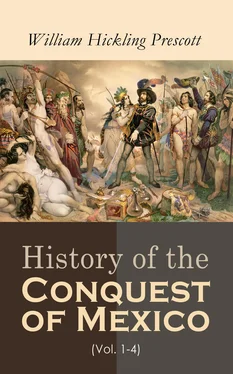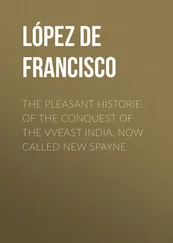[247]Torquemada, Monarch. Ind., lib. 2, cap. 41.—Ixtlilxochitl gives a curious story of one of the royal family of Tezcuco, who offered, with two other merchants, otros mercaderes , to visit the court of a hostile cacique and bring him dead or alive to the capital. They availed themselves of a drunken revel, at which they were to have been sacrificed, to effect their object. Hist. Chich., MS., cap. 62.
[248]Sahagun, Hist. de Nueva-España, lib. 9, cap. 2, 5.—The ninth book is taken up with an account of the merchants, their pilgrimages, the religious rites on their departure, and the sumptuous way of living on their return. The whole presents a very remarkable picture, showing they enjoyed a consideration, among the half-civilized nations of Anahuac, to which there is no parallel, unless it be that possessed by the merchant-princes of an Italian republic, or the princely merchants of our own.
[249]Sahagun, Hist. de Nueva-España, lib. 6, cap. 23-37.—Camargo, Hist. de Tlascala, MS.—These complimentary attentions were paid at stated seasons, even during pregnancy. The details are given with abundant gravity and minuteness by Sahagun, who descends to particulars which his Mexican editor, Bustamante, has excluded, as somewhat too unreserved for the public eye. If they were more so than some of the editor’s own notes, they must have been very communicative indeed.
[250]Zurita, Rapport, pp. 112-134.—The Third Part of the Col. de Mendoza (Antiq. of Mexico, vol. i.) exhibits the various ingenious punishments devised for the refractory child. The flowery path of knowledge was well strewed with thorns for the Mexican tyro.
[251]Zurita, Rapport, pp. 151-160.—Sahagun has given us the admonitions of both father and mother to the Aztec maiden on her coming to years of discretion. What can be more tender than the beginning of the mother’s exhortation? “Hija mia muy amada, muy querida palomita: ya has oido y notado las palabras que tu señor padre te ha dicho; ellas son palabras preciosas, y que raramente se dicen ni se oyen, las quales han procedido de las entrañas y corazon en que estaban atesoradas; y tu muy amado padre bien sabe que eres su hija, engendrada de él, eres su sangre y su carne, y sabe Dios nuestro señor que es así; aunque eres muger, é imágen de tu padre ¿que mas te puedo decir, hija mia, de lo que ya esta dicho? “ (Hist. de Nueva-España, lib. 6, cap. 19.) The reader will find this interesting document, which enjoins so much of what is deemed most essential among civilized nations, translated entire in the Appendix, Part 2, No. 1.
[252]Yet we find the remarkable declaration, in the counsels of a father to his son, that, for the multiplication of the species, God ordained one man only for one woman. “Nota, hijo mio, lo que te digo, mira que el mundo ya tiene este estilo de engendrar y multiplicar, y para esta generacion y multiplicacion, ordenó Dios que una muger usase de un varon, y un varon de una muger.” Sahagun, Hist. de Nueva-España, lib. 6, cap. 21.
[253]Ibid., lib. 6, cap. 21-23; lib. 8, cap. 23.—Rel. d’un gentil’ huomo, ap. Ramusio, tom. iii. fol. 305.—Carta del Lic. Zuazo, MS.
[254]As old as the heroic age of Greece, at least. We may fancy ourselves at the table of Penelope, where water in golden ewers was poured into silver basins for the accommodation of her guests, before beginning the repast:
“Χέρνιβα δʹ ἀμφίπολος προχόῳ ἐπέχευε φέρουσα
Καλῇ χρυσείῃ ὑπὲρ ἀργυρέοιο λέβητος,
Νίψασθαι: παρὰ δὲ ξεστὴν ἐτάνυσσε τράπεζαν.”
ΟΔΥΣΣ. Α.
The feast affords many other points of analogy to the Aztec, inferring a similar stage of civilization in the two nations. One may be surprised, however, to find a greater profusion of the precious metals in the barren isle of Ithaca than in Mexico. But the poet’s fancy was a richer mine than either.
[255]Sahagun, Hist. de Nueva-España, lib. 6, cap. 22.—Amidst some excellent advice of a parent to his son, on his general deportment, we find the latter punctiliously enjoined not to take his seat at the board till he has washed his face and hands, and not to leave it till he has repeated the same thing, and cleansed his teeth . The directions are given with a precision worthy of an Asiatic. “Al principio de la comida labarte has las manos y la boca, y donde te juntares con otros á comer, no te sientes luego; mas antes tomarás el agua y la jícara para que se laben los otros, y echarles has agua á las manos, y despues de esto, cojerás lo que se ha caido por el suelo y barrerás el lugar de la comida, y también despues de comer lavarás te las manos y la boca, y limpiarás los dientes.” Ibid., loc. cit.
[256]Rel. d’un gentil’ huomo, ap. Ramusio, tom. iii. fol. 306.—Sahagun, Hist. de Nueva-España, lib. 4, cap. 37.—Torquemada, Monarch. Ind., lib. 13, cap. 23.—Clavigero, Stor. del Messico, tom. ii. p. 227.—The Aztecs used to smoke after dinner, to prepare for the siesta , in which they indulged themselves as regularly as an old Castilian.—Tobacco, in Mexican yetl , is derived from a Haytian word, tabaco . The natives of Hispaniola, being the first with whom the Spaniards had much intercourse, have supplied Europe with the names of several important plants.—Tobacco, in some form or other, was used by almost all the tribes of the American continent, from the Northwest Coast to Patagonia. (See McCulloh, Researches, pp. 91-94.) Its manifold virtues, both social and medicinal, are profusely panegyrized by Hernandez, in his Hist. Plantarum, lib. 2, cap. 109.
[257]This noble bird was introduced into Europe from Mexico. The Spaniards called it gallopavo , from its resemblance to the peacock. See Rel. d’un gentil’ huomo, ap. Ramusio (tom. iii. fol. 306); also Oviedo (Rel. Sumaria, cap. 38), the earliest naturalist who gives an account of the bird, which he saw soon after the Conquest, in the West Indies, whither it had been brought, as he says, from New Spain. The Europeans, however, soon lost sight of its origin, and the name “turkey” intimated the popular belief of its Eastern origin. Several eminent writers have maintained its Asiatic or African descent; but they could not impose on the sagacious and better-instructed Buffon. (See Histoire naturelle, art. Dindon .) The Spaniards saw immense numbers of turkeys in the domesticated state, on their arrival in Mexico, where they were more common than any other poultry. They were found wild, not only in New Spain, but all along the continent, in the less frequented places, from the Northwestern territory of the United States to Panamá. The wild turkey is larger, more beautiful, and every way an incomparably finer bird than the tame. Franklin, with some point, as well as pleasantry, insists on its preference to the bald eagle as the national emblem. (See his Works, vol. x. p. 63, in Sparks’s excellent edition.) Interesting notices of the history and habits of the wild turkey may be found in the Ornithology both of Buonaparte and of that enthusiastic lover of nature, Audubon, vox Meleagris , Gallopavo .
[258]Sahagun, Hist. de Nueva-España, lib. 4, cap. 37; lib. 8, cap. 13; lib. 9, cap. 10-14.—Torquemada, Monarch. Ind., lib. 13, cap. 23.—Rel. d’un gentil’ huomo, ap. Ramusio, tom. ii. fol. 306.—Father Sahagun has gone into many particulars of the Aztec cuisine , and the mode of preparing sundry savory messes, making, all together, no despicable contribution to the noble science of gastronomy.
[259]The froth, delicately flavored with spices and some other ingredients, was taken cold by itself. It had the consistency almost of a solid; and the “Anonymous Conqueror” is very careful to inculcate the importance of “opening the mouth wide, in order to facilitate deglutition, that the foam may dissolve gradually, and descend imperceptibly, as it were, into the stomach.” It was so nutritious that a single cup of it was enough to sustain a man through the longest day’s march. (Fol. 306.) The old soldier discusses the beverage con amore .
Читать дальше












